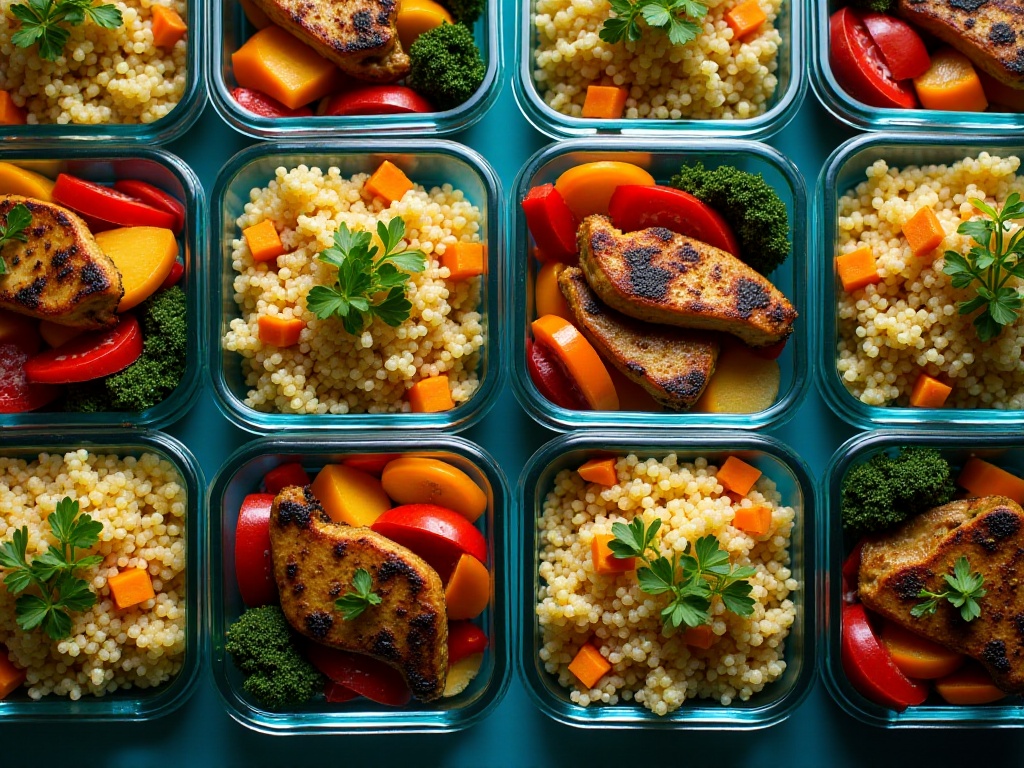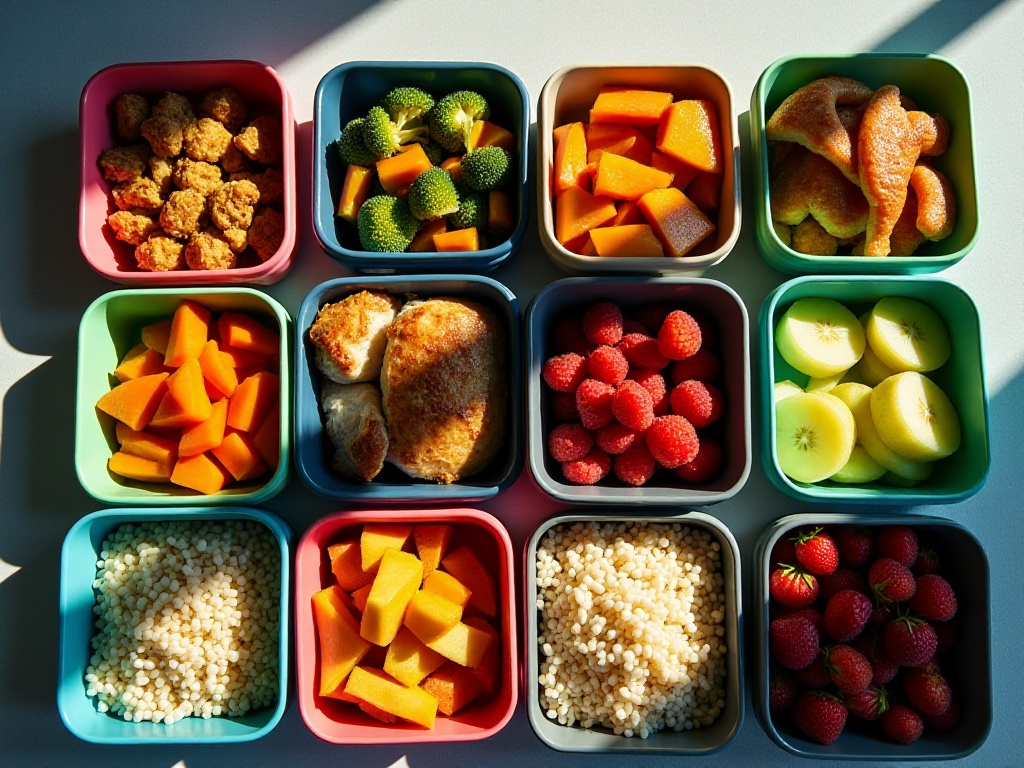
Opening Reflections
Every time I see fitness influencers' daily meals, I think: "This time I'll definitely start eating healthy!" However, reality is often cruel - either I'm inconsistent with my efforts, or I force myself to eat foods I completely dislike in the name of "health." After a long period of trial and error, I finally found a healthy eating approach that works for me. As someone who started from knowing nothing, I'd like to share my journey and practical experience today.
Building the Foundation
When it comes to healthy eating, many people's first reaction is: "I need to follow X influencer's salad diet" or "I need to learn Y celebrity's weight loss meal plan." But honestly, blindly following trends will only lead you further down the path of self-torture. Before officially starting, we need to build a solid foundation. Just like setting up your character's equipment in a game, without a solid foundation, everything else is pointless.
First, we need to reorganize our kitchen supplies. I'll never forget the scene when I first decided to eat healthy: opening the refrigerator to find it full of instant foods, snacks, and drinks. Instant noodles, sausages, and all kinds of snacks were everywhere, but not a single healthy ingredient could be found. So step one is to thoroughly clean out the kitchen and remove all the junk food.
However, just removing unhealthy foods isn't enough; we also need to stock up on healthy ingredients. Now my refrigerator regularly contains: skinless chicken breast (high protein, low fat option), salmon (rich in omega-3 fatty acids), various seasonal vegetables (including broccoli, spinach, carrots, etc.), seasonal fruits (strawberries, blueberries, dragon fruit, etc.). The pantry contains quinoa (called a "superfood"), brown rice (higher nutritional value than white rice), oats (helps control cholesterol) and other whole grains, as well as nuts (almonds, walnuts, cashews, etc.) and herbs (rosemary, thyme, black pepper, etc.).
These ingredients might seem "professional," but they're actually easy to find in large supermarkets or online. Plus, they have relatively long shelf lives, so there's no need to worry about waste from buying too much. I usually do all my shopping on weekends, which saves time and ensures fresh ingredients.

Eating Patterns
After transforming the kitchen environment into "healthy mode," the next step is establishing new eating patterns. Many people try to make all three meals healthy at once, but this often leads to too much pressure and giving up. My suggestion is to start with breakfast. Why breakfast? Because it's the easiest meal of the day to control, unaffected by business meals, gatherings, or other external factors. Moreover, a nutritious breakfast provides sufficient energy and makes it easier to make healthy food choices throughout the rest of the day.
Speaking of breakfast, I'd like to share my current regular combination: I use oatmeal (about 40g) with unsweetened soy milk or regular milk, plus some fruit (like half a banana or a handful of blueberries) and nuts (about 10g). This breakfast is not only nutritionally balanced (carbs + protein + healthy fats) but also very convenient to prepare - it usually takes only 15 minutes from preparation to finishing the meal. Remember, convenience is a crucial factor in maintaining a good habit. If a habit is too troublesome, it's hard to stick to even if it's healthy.
As the breakfast habit became established, I gradually adjusted my lunch and dinner. Lunch usually includes a portion of protein (like chicken breast or fish), a portion of whole grains (like brown rice or quinoa), and plenty of vegetables. Dinner is relatively lighter, focusing on protein and vegetables with reduced carbohydrate intake.
However, it's important to note that this eating pattern isn't set in stone. Sometimes during friend gatherings or special occasions, I allow myself to enjoy an "indulgent" meal. The important thing is to remember that occasional relaxation won't affect the overall healthy eating plan; the key is being able to get back on track promptly.

Practical Tips
After covering the theory, let's share some specific practical tips. First is ingredient storage and preparation. I've developed a habit of dedicating 2-3 hours every Sunday afternoon to food preparation. This might seem like a long time, but it makes eating throughout the week much easier.
Specifically, I: Clean and cut vegetables, categorize them, and store them in containers. For example, cutting broccoli into florets and carrots into strips makes them readily available whenever needed, which is very convenient.
Cook a week's worth of staple foods, usually brown rice or quinoa. I cook it all at once in a rice cooker, then divide it into small portions for freezing. When needed, just take it out and heat it up.
Slice chicken breast, marinate it simply with olive oil, black pepper, rosemary, etc., then portion and freeze it. This way, whenever needed, it can be taken out and baked or pan-fried, creating a delicious main dish in 15 minutes.
Besides food preparation, I'd also like to share some practical cooking tips. Many people think healthy eating means eating boiled vegetables, but that's not true. With proper use of herbs and seasonings, healthy ingredients can be just as delicious.
For example, I particularly enjoy using herbs to enhance food flavors. Rosemary with chicken breast, curry with shrimp, ginger with salmon - these are all excellent combinations. These herbs not only make food more delicious but many also have health benefits like anti-inflammatory properties and immune system boosting effects.
Additionally, I use healthy cooking methods to replace traditional frying. For instance, using an air fryer to make crispy chicken breast, roasting vegetables in the oven, or steaming fish. These methods preserve the nutrients in ingredients without adding excessive oil.

Continuous Improvement
After such a long period of practice, I deeply understand that building healthy eating habits is a process requiring constant adjustment and improvement. It's impossible to achieve overnight, and there's no perfect solution that fits everyone.
My advice is to focus on changing just one small habit at a time, and only move on to the next one after the current habit is truly formed. For example, I started by increasing my water intake. I bought a large thermal cup to carry with me. At first, I might often forget to drink water, but gradually it became a habit, and now I can easily drink 2000ml of water daily.
Only after establishing the water-drinking habit did I try to change breakfast. At first, oatmeal might not taste good, but through constantly trying different combinations (like adding different fruits, nuts, or trying different brands of oats), I finally found combinations I enjoy.
Then came lunch - I started trying to pack my own. Initially, it might seem troublesome, but through the food preparation techniques mentioned earlier, I can now handle it easily. Dinner was the last to change because I had to consider family eating habits, so the change process was slower and more flexible.
During this process, I've also been continuously learning and exploring. For example, learning about the nutritional value of different ingredients, studying new cooking methods, and even researching basic nutrition knowledge. This knowledge not only helps me make better food choices but also helps me understand why I should eat this way.
Sometimes there might be setbacks, like being too busy at work to prepare ingredients, or not being able to eat according to plan while traveling. But the important thing is not to completely give up because of temporary deviations. Remember, healthy eating is an ongoing process, and occasional mistakes are completely understandable and acceptable.

Summary of Insights
Looking back on this journey, my biggest realization is that healthy eating isn't a short sprint but a marathon that requires sustained commitment. Don't expect immediate results; focus on long-term changes instead.
The important thing is finding what works for you. Don't blindly follow others' diet plans; instead, create a plan based on your own circumstances (including lifestyle, work environment, personal taste, etc.). Also maintain sufficient patience and perseverance, because forming any habit takes time.
Now I can maintain healthy eating habits relatively easily. While it might not be perfect, it's definitely sustainable. Most importantly, I feel more energetic and my mood has improved.
This is my healthy eating journey. If you're also starting this journey, I hope my experience can provide some inspiration. Remember, everyone's path is different; what's important is finding what works for you and sticking with it.
What do you think? Feel free to share your healthy eating experiences and insights. Let's continue moving forward together on the path of healthy eating.
Next
Smart People's Nutrition Management Tips for Effortless Health and Fitness
A comprehensive guide to healthy eating and nutrition, covering balanced diet composition, healthy eating habits, and practical tips. Detailed information on choosing carbohydrates, proteins, healthy fats, and strategies for diverse fruit and vegetable intake
Done Being a Nutrition Novice? This Comprehensive Nutrition Guide Will Help You Eat Scientifically Starting Today
A comprehensive guide exploring core principles of balanced nutrition and healthy eating, including nutritional optimization advice, scientific dietary methods, and practical meal management tips to help readers establish healthy eating habits
A Nutritionist Tells You: This is How to Eat Healthy Without Too Much Hassle - I've Been Practicing for 3 Years
A comprehensive guide to healthy eating and nutrition improvement, covering dietary principles, habit formation, and practical tips on whole grain selection, fruit and vegetable combinations, and protein intake for a balanced diet
Next

Smart People's Nutrition Management Tips for Effortless Health and Fitness
A comprehensive guide to healthy eating and nutrition, covering balanced diet composition, healthy eating habits, and practical tips. Detailed information on choosing carbohydrates, proteins, healthy fats, and strategies for diverse fruit and vegetable intake

Done Being a Nutrition Novice? This Comprehensive Nutrition Guide Will Help You Eat Scientifically Starting Today
A comprehensive guide exploring core principles of balanced nutrition and healthy eating, including nutritional optimization advice, scientific dietary methods, and practical meal management tips to help readers establish healthy eating habits

A Nutritionist Tells You: This is How to Eat Healthy Without Too Much Hassle - I've Been Practicing for 3 Years
A comprehensive guide to healthy eating and nutrition improvement, covering dietary principles, habit formation, and practical tips on whole grain selection, fruit and vegetable combinations, and protein intake for a balanced diet
